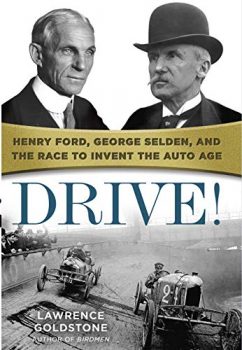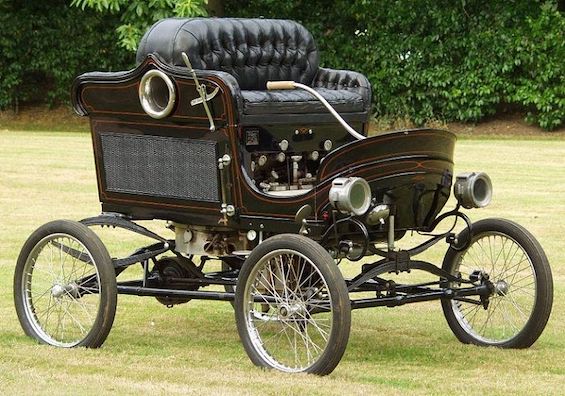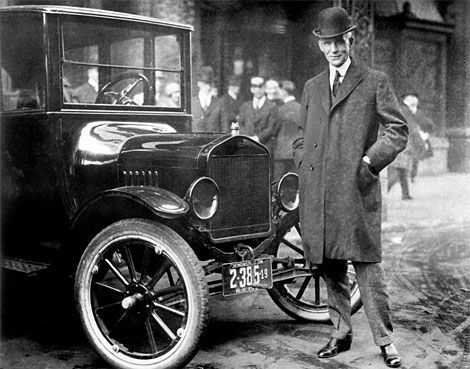
At first, before Henry Ford, before the twentieth century, the automobile was not a sure thing. In fact, it was a downright nuisance.
- For starters, they couldn’t agree on what to call it. A “road machine?” “Automotor horse?” “Buggyaut?” “Horseless carriage?”
- They didn’t know what fuel to use. Steam? Kerosene? Coal gas? Electricity? Maybe gasoline?
- Many people were even sure how many wheels to put on it. Three? Four? Or how those wheels should be made. Wood? Cast iron? Solid rubber?
- And, more to the point, where could they possibly drive these contraptions? Outside major cities, and often in them as well, roads were unpaved, often nonexistent. And in the cities, the noise they made, and the terror they instilled in both the people and the horses that dominated the streets, kept their drivers constantly at risk of arrest for disturbing the peace.
No, manufacturing automobiles was a chancy thing for a very long time. And in Lawrence Goldstone‘s thrilling account of its evolution, Drive!, you’ll learn just how close a thing it was that the automobile came to be the dominant technology of the twentieth century. Along the way, you’ll encounter the facts about Henry Ford‘s role in the process and how far they depart from the myth.
Drive! Henry Ford, George Selden, and the Race to Invent the Auto Age by Lawrence Goldstone (2019) 511 pages ★★★★★

Before Henry Ford, the automobile was not a sure thing
So, you think Henry Ford invented the automobile? Guess again. During the technology’s evolution during the closing decades of the nineteenth century, he wasn’t even in the mix. (He didn’t even start his first company until 1899.) And the Model T that made his name and secured his fortune didn’t go into production until 1908. Consider this passage Goldstone excerpts from a book entitled The Road to the Model T:
Of the 2,500 motor vehicles counted in the United States Census of Manufactures for 1899, the vast majority were steam and electric-powered carriages . . . By 1900 steamer sales had inched past electrics [and] maintained this lead through 1902. . . Not until 1903, when the Olds Motor Vehicle Company’s curved-dash Oldsmobile led the industry with 4,000 sales, did gasoline-powered carriages become dominant.
Before Henry Ford, others pioneered mass production
In fact, only once Ford launched his first genuinely successful car, the Model N in 1906, did he begin to emerge from the pack as a leader in the new industry—not the leader, but one of many. And, “despite the mythology that would settle around him only a few years later, Henry Ford at that point knew next to nothing about interchangeable parts, mass production, or even how to effectively set up a factory.” In fact, “there is no significant invention in automobile technology for which Ford could personally take credit.” And it wasn’t until 1913 that Ford began turning cars out on a moving assembly-line.
Ford’s biggest decision was to fight a lawsuit
Goldstone makes clear that Ford’s greatest strength did not lie in his limited talents as an inventor or mechanic. He was, in fact, a brilliant manager and businessman. During his early years in the industry, he outsourced the production of the critical parts of his cars because others (chiefly the Dodge brothers) were far better at manufacturing than he was. And he hired men to fill senior positions he despised but tolerated them because they were so good at their jobs. (For example, architect Albert Kahn was a Jew, yet Ford was a virulent anti-Semite.) However, one of the biggest business decisions Henry Ford ever made was to fight a lawsuit. And that lawsuit is the centerpiece of Goldstone’s story.
Before Henry Ford, Europe led the way in automobile technology
During the nineteenth century, automobile technology was far more advanced in Europe than in the United States. Men such as Karl Benz, Gottlieb Daimler, and Wilhelm Maybach pioneered the industry, and the French (including Armand Peugeot and Louis Renault) were quick to follow. But “George Selden was the first American attempting to build a gasoline automobile, and the first to conceive of a multicylinder motor to power it.” In 1879, he filed a patent for such a machine even though he had been unsuccessful in his attempts to build one. A gifted patent attorney himself, he kept the patent pending until 1895. He still hadn’t built an automobile, but he set out to demand royalties from those who had.
That lawsuit set the stage for the growth of the auto industry
However, “none of the scores of manufacturers of genuine automobiles offered him licensing fees, and Selden lacked the resources to demand any.” That was not the case, though, with the sharp-eyed Wall Street lawyers and investors who banded together “to form the Association of Licensed Automobile Manufacturers (ALAM), which would pay modest royalties to the Selden group but would also be allowed to restrict membership and thus licenses to manufacturers of their choosing.” Ford applied for membership, indicating his willingness to pay the licensing fees. But his direct competitor, the Olds Motor Works, effectively blackballed him. ALAM then filed suit against Ford and threatened to do so against anyone who bought one of his autos. The ensuing battle in court lasted for eight years. Ford lost the original ruling in 1909 but won on appeal two years later, by which point he was already the country’s leading auto manufacturer.

For related reading
This is one of My 10 favorite books about business history.
You might also be interested in Top 20 popular books for understanding American history and 20 top nonfiction books about history.
And you can always find my most popular reviews, and the most recent ones, on the Home Page.



























